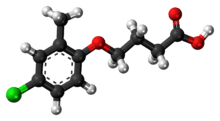MCPB
 | |
 | |
| Names | |
|---|---|
| IUPAC name
4-(4-Chloro-2-methylphenoxy)butanoic acid | |
| Identifiers | |
| 94-81-5 | |
| 3D model (Jmol) | Interactive image |
| ChemSpider | 6938 |
| ECHA InfoCard | 100.002.151 |
| PubChem | 7207 |
| |
| |
| Properties | |
| C11H13ClO3 | |
| Molar mass | 228.67 g/mol |
| Except where otherwise noted, data are given for materials in their standard state (at 25 °C [77 °F], 100 kPa). | |
| | |
| Infobox references | |
MCPB, 2,4-MCPB, 4-(4-chloro-o-tolyloxy)butyric acid (IUPAC), or 4-(4-chloro-2-methylphenoxy)butanoic acid (CAS) is a phenoxybutyric herbicide. In the United States it is registered for use on pea crops before flowering, for post-emergence control of broadleaf annual and perennial weeds including Canadian thistle, buttercup, mustard, purslane, ragweed, common lambsquarters, pigweed, smartweed, sowthistle, and morning glory. It has low to moderate acute toxicity, with kidney and liver effects as the main hazard concerns. It is not volatile, persistent, or likely to bioconcentrate. The maximum residue permitted on peas is 0.1 parts per million.[1]
References
- ↑ "RED FACTS; MCPB". US EPA.
External links
- MCPB in the Pesticide Properties DataBase (PPDB)
This article is issued from Wikipedia - version of the 8/1/2015. The text is available under the Creative Commons Attribution/Share Alike but additional terms may apply for the media files.